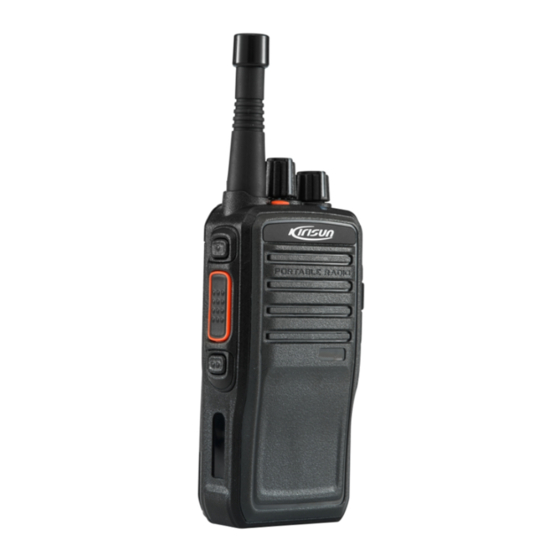
Table of Contents
Advertisement
Advertisement
Table of Contents

Summarization of Contents
Safety Precautions
General Safety Guidelines
Ensures safe operation and adherence to local laws and regulations governing RF products.
RF Energy Exposure and Interference
Discusses RF energy exposure, health risks, and interference with electronic devices.
Safe Operation in Hazardous Environments
Highlights that the radio is not intrinsically safe and not for hazardous environments.
Hearing Protection and Driving Safety
Warns against placing the radio near the ear and advises obeying traffic laws when operating.
Antenna Handling and Operational Conditions
Provides guidelines for antenna use, avoiding damage, and operating within specified temperature ranges.
Accessory Usage and Care
Recommends Kirisun approved accessories and general care for the product.
Vehicle Installation and Servicing
Covers safe installation in vehicles and emphasizes professional servicing for repairs.
Regulatory Compliance
European Directives and Waste Disposal
Confirms compliance with European directives and instructs on proper disposal of equipment and batteries.
Product Care and Maintenance
General Cleaning and Care Instructions
Provides instructions for daily cleaning with a soft cloth and periodic battery contact cleaning.
Device Components Overview
Connectors, Controls, and Keys Identification
Illustrates and labels various connectors, controls, buttons, and keys on the device.
Control Functions
Key, Button, and Knob Operation
Explains the functions of the power/volume knob, channel selector, top button, and side buttons.
Status Indicators
LED Status Indicator Meanings
Details the operational states indicated by different LED colors and patterns.
Battery Management
Battery Information and Safety
Provides information on the supplied battery and essential safety precautions for its use.
Battery Storage and Transportation Guidelines
Offers guidelines for storing and transporting batteries to maintain capacity and life.
Battery Charging Procedures
Explains the initial charging requirements for new batteries and typical charging times.
Accessories and Attachments
Battery Installation and Removal
Details the steps for correctly fitting and removing the device battery.
Antenna and Belt Clip Installation
Guides on how to properly fit the antenna and attach the belt clip to the device.
Connecting Cables and Earphones
Explains how to connect programming cables and fit optional earphones.
Basic Operation
Power, Standby, and Volume Control
Covers powering the radio on/off, entering standby mode, and adjusting volume levels.
Channel Selection
Details how to change channels or groups using the channel selector knob.
Call Duration and Handling
Explains call duration settings and procedures for making and receiving PTT calls.
Delay Access
Allows access to ongoing group calls after a specified delay.
Priority and Group Calling
Covers setting call priorities and initiating group calls.
Individual, All, and Duplex Calls
Explains how to make individual, all, and duplex calls.
Historical Records and Position Reporting
Details playback of historical call records and GPS position reporting features.
Low Battery Alerts
Describes the audio and visual alerts for low battery status.
Technical Specifications
General and Frequency Band Information
Provides general specifications including communication modes and frequency bands.
Device Features
Covers features like remote programming, WIFI network access, and advanced signalling functions.
Physical and Environmental Specifications
Details channel spacing, operating/storage temperatures, power, battery, dimensions, weight, and protection ratings.
Transmitter Performance
Lists RF power output, frequency stability, and audio distortion for the transmitter.
Receiver Performance
Details receiver frequency stability, sensitivity, rated audio power, and distortion.
RF Exposure Information
Using Your Phone Safely
Provides warnings and guidelines for safe usage to comply with FCC RF exposure standards.
Body-Worn Operation Guidelines
Specifies minimum separation distances for body-worn operations to meet FCC requirements.
Interference and Device Operation
Details FCC compliance, interference guidelines, and operational environment limits.
Industry Canada Compliance
RSS Standards and Body-Worn Operation
Outlines Industry Canada compliance, RSS standards, and body-worn operation requirements.
RF Exposure Information (IC)
Confirms SAR compliance with IC RSS-102 and provides links for further information.










Need help?
Do you have a question about the W65 and is the answer not in the manual?
Questions and answers